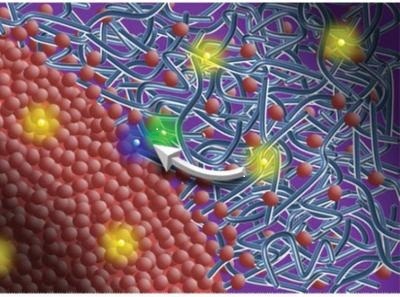New path to more efficient organic solar cells
The amount of solar energy lighting up Earth’s land mass every year is nearly 3000 times the total amount of annual human energy use. But to compete with energy from fossil fuels, photovoltaic devices must convert sunlight to electricity with a certain measure of efficiency. For polymer-based organic photovoltaic cells, which are far less expensive to manufacture than silicon-based solar cells, scientists have long believed that the key to high efficiencies rests in the purity of the polymer/organic cell’s two domains - acceptor and donor. Now, however, an alternate and possibly easier route forward has been shown.
Working at Berkeley Lab’s Advanced Light Source (ALS), a premier source of X-ray and ultraviolet light beams for research, an international team of scientists found that for highly efficient polymer/organic photovoltaic cells, size matters.
“We’ve shown that impure domains if made sufficiently small can also lead to improved performances in polymer-based organic photovoltaic cells,” says Harald Ade, a physicist at North Carolina State University who led this research. “There seems to be a happy medium, a sweet-spot of sorts, between purity and domain size that should be much easier to achieve than ultrahigh purity.”

Ade, a longtime user of the ALS, is the corresponding author of a paper describing this work in advanced energy materials titled ‘Absolute measurement of domain composition and nanoscale size distribution explains performance in PTB7:PC71 BM solar cells’.
Solar cell conversion efficiency in polymer/organic photovoltaic cells hinges on excitons - electron/hole pairs energised by sunlight - getting to the interfaces of the donor and acceptor domains quickly so as to minimise energy lost as heat. Conventional wisdom held that the greater the purity of the domains, the fewer the impedances and the faster the exciton journey.
Ade and his co-authors became the first to simultaneously measure the domain size, composition and crystallinity of an organic solar cell. This feat was made possible by ALS beamlines 11.0.1.2, a resonant soft X-ray scattering facility; 7.3.3, a small- and wide-angle X-ray scattering end-station; and 5.3.2, an end-station for scanning transmission X-ray microscopy.
The combination of these three ALS beamlines enabled the researchers to obtain comprehensive pictures of polymer-based organic photovoltaic film morphology from the nano- to the mesoscales which, until now, have been unattainable.
The international team used the trifecta of ALS beams to study the polymer/fullerence blend PTB7:PC71BM in thin films made from chlorobenzene solution with and without the addition (3% by volume) of diiodooctane. The films were composed of droplet-like dispersions in which the dominant acceptor domain size without the additive was about 177 nm. The addition of the solvent shrank the acceptor domain size down to about 34 nm while preserving the film's composition and crystallinity. This resulted in an efficiency gain of 42%.
Soft robot uses magnetic fields to power itself autonomously
Inspired by the movement of manta rays, researchers have developed a small, magnetically powered...
Perovskite 'energy sandwich' could power next-gen solar
Researchers have achieved a new level of control over the atomic structure of halide perovskites,...
Creating the truck of tomorrow
Exploring the technological innovations, infrastructure solutions and emerging delivery methods...





